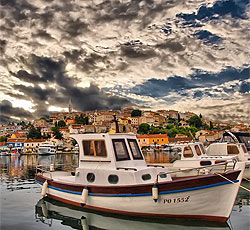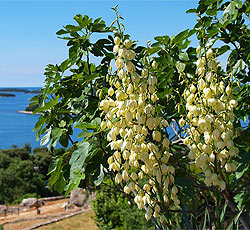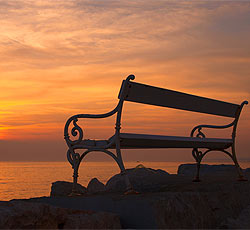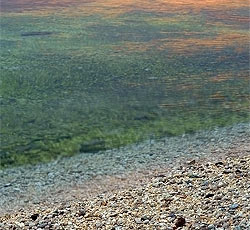-
Vrsar Archipelago (Vrsar, Istria)
It consists of 18 unpopulated green islands and islets, including: Figarolica, Lakal, Salamon, Zavata, Galiner, Sv. Juraj, Gusti skolj, Koversada i Orlandin. -
Giacomo Casanova Street (Vrsar, Istria)
The Italian adventurer and writer Giacomo Casanova stopped in Vrsar twice during the 18th century (in 1743 and 1749) and he wrote about it in his famous memoirs. According to the legend, Casanova did not just spend his summer holidays in Vrsar but took up residence there, so a Vrsar street containing La Casa di Rose, his alleged residence, was named after him. -
The Fkk Beach Koversada (Vrsar, Istria)
The Beach Koversada is situated under the same name camp and touristic settlement. It stretches 5 km along the coast with the various beaches. At the middle sandy beach the access for the people with special needs is arranged. One part of the beach is allowed for the dogs. Near the beach are few fun and recreational contents and is possible to rent deck chairs and umbrellas.
Fkk Beach Koversada Info -
The park of Dušan Dzamonja’s sculptures (Vrsar, Istria)
The protected house and Sculpture Park complex belonging to the greatest Croatian and European contemporary sculptor Dušan Džamonja, whose sculptures are exhibited in the most renowned museums of the world, is spread over an area in Vrsar which provides a view of one of the most beautiful archipelagos in the Mediterranean. The Sculpture Park has contained sculptures, graphics and drawings since 1970. -
Old Romanesque Gate (Vrsar, Istria)
The gate was built in the second half of the 17th century or the first half of the 18th century when the architecture and stone work in the towns of Istria turned to Romanesque style. The gate was included in the town wall system. It contains a fragment of the town walls and tablet with a shallow relief of St. Mark’s lion – a symbol of the Venetian rule.
Old Romanesque Gate Info
Vrsar, Cestovní průvodce pro dovolenou ve Vrsaru, Istrie
Vrsar Kultura
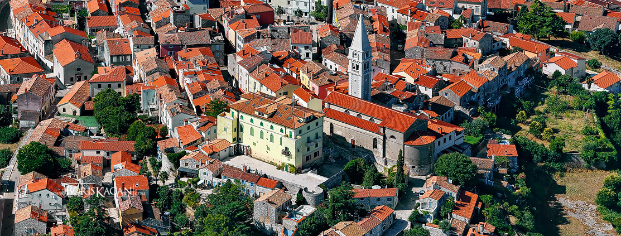 Úzké uličky vedoucí k městské bráně, malá náměstí, kamenné domy, malebné kostely a tři letohrádky. Pohled na pobřeží Vrsaru je skutečně okouzlující: najdete zde nejčlenitejší pláže z celé Istrie s množstvím soustroví včetně 18 neobydlených ostrůvků a dokonale čisté, průzračné Jaderské moře. Vrsar se pyšní také bohatou historií, která sahá až do období antiky. Oblast je od pradávna známá svými prameny pitné vody, které jí nakonec daly jméno: Ursaria (strobylý výraz "ur" je označením pro "pramen") a nedalekou Funtanou (fontána). Ta je ideálním místem pro odpočinek a osvěžení. Italský dobrodruh Giacomo Casanova strávil v romantickém Vrsaru letní období 1743 a 1744 a toto půvabné letovisko zmiňuje ve svých pamětech. Díky produkci soli byl Vrsar ve středověku významným místem a v jeho ulicích najdete vysoce kvalitní šedý kámen, který byl rovněž použitý při výstavbě Benátek. Vrsar se proslavil také jako město sochařů a nachází se zde slavný park Dušana Džamonji. Kamenné sochy zdobí celé město a jejich počet každoročně stoupá: v kamenolomu Montraker se totiž každé léto koná sochařská škola. Vrsar obklopují vinice a olivové háje a nedaleká chráněná oblast Limského kanálu je místem chovu mořských plodů. Vrsar je tedy skvělou destinací pro všechny milovníky vína a vybraných pochoutek. Vrsar byl několikrát vyhlášen nejlepší turistickou destinací Jadranu a není tedy překvapením, že cestovní ruch tvoří velkou část vrsarských příjmů. Oblast se hodí jak pro milovníky aktivní dovolené, tak pro rodiny s dětmi. V současnosti je Vrsar známý také díky velkému přístavu Koversada.
Úzké uličky vedoucí k městské bráně, malá náměstí, kamenné domy, malebné kostely a tři letohrádky. Pohled na pobřeží Vrsaru je skutečně okouzlující: najdete zde nejčlenitejší pláže z celé Istrie s množstvím soustroví včetně 18 neobydlených ostrůvků a dokonale čisté, průzračné Jaderské moře. Vrsar se pyšní také bohatou historií, která sahá až do období antiky. Oblast je od pradávna známá svými prameny pitné vody, které jí nakonec daly jméno: Ursaria (strobylý výraz "ur" je označením pro "pramen") a nedalekou Funtanou (fontána). Ta je ideálním místem pro odpočinek a osvěžení. Italský dobrodruh Giacomo Casanova strávil v romantickém Vrsaru letní období 1743 a 1744 a toto půvabné letovisko zmiňuje ve svých pamětech. Díky produkci soli byl Vrsar ve středověku významným místem a v jeho ulicích najdete vysoce kvalitní šedý kámen, který byl rovněž použitý při výstavbě Benátek. Vrsar se proslavil také jako město sochařů a nachází se zde slavný park Dušana Džamonji. Kamenné sochy zdobí celé město a jejich počet každoročně stoupá: v kamenolomu Montraker se totiž každé léto koná sochařská škola. Vrsar obklopují vinice a olivové háje a nedaleká chráněná oblast Limského kanálu je místem chovu mořských plodů. Vrsar je tedy skvělou destinací pro všechny milovníky vína a vybraných pochoutek. Vrsar byl několikrát vyhlášen nejlepší turistickou destinací Jadranu a není tedy překvapením, že cestovní ruch tvoří velkou část vrsarských příjmů. Oblast se hodí jak pro milovníky aktivní dovolené, tak pro rodiny s dětmi. V současnosti je Vrsar známý také díky velkému přístavu Koversada. 